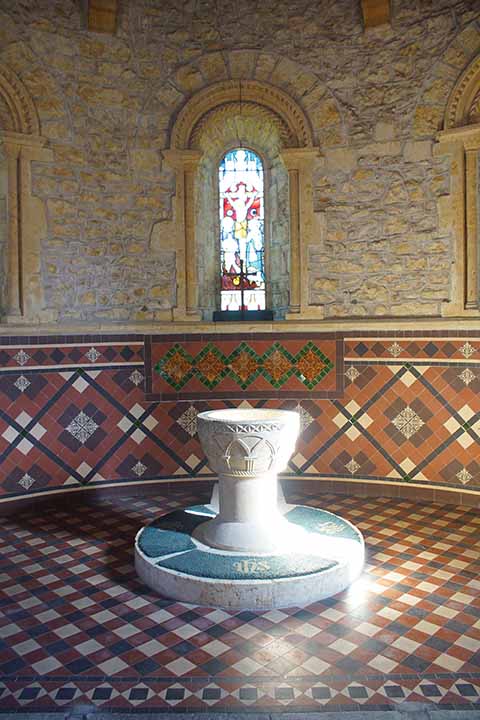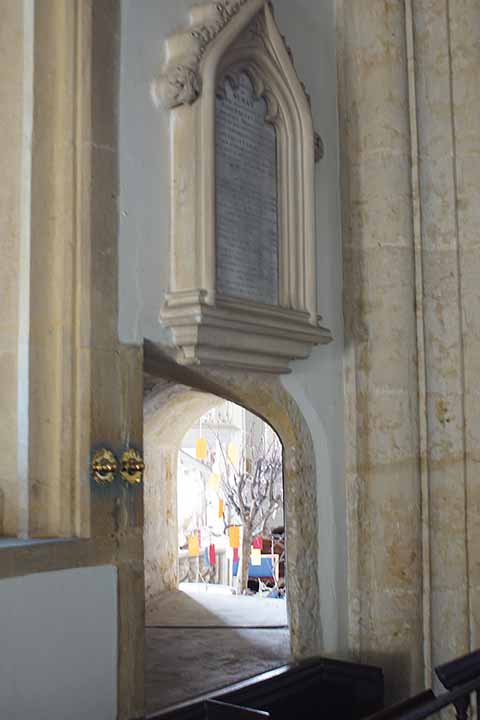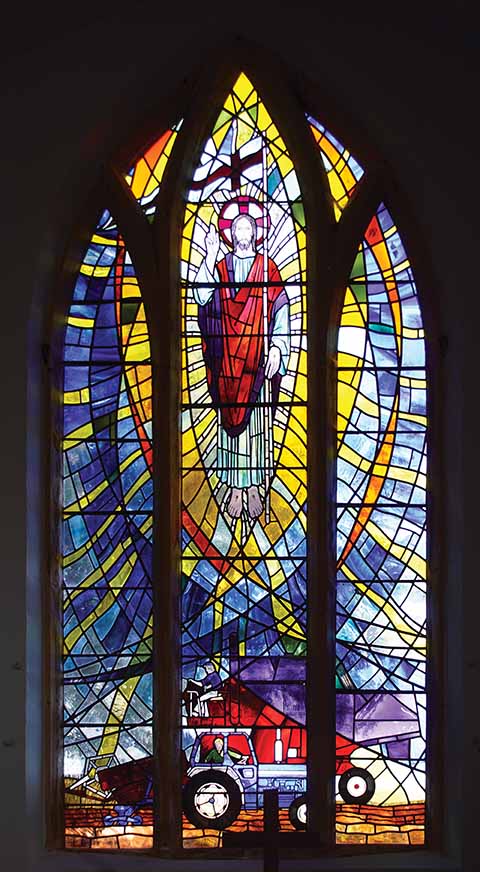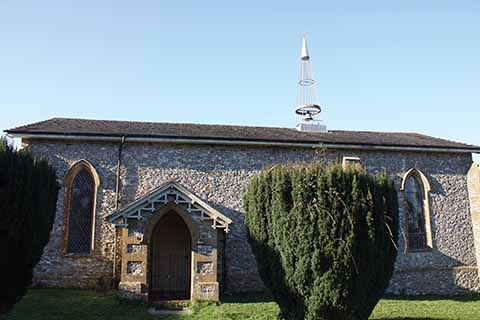Beaminster’s string of pearls
Surrounding Beaminster's St Mary of the Annunciation are the thirteen other churches in the Beaminster team ministry. Joël Lacey visited all fourteen on a single spring afternoon.
Published in May ’19

The lovely tiled area in the apsidal end housing the font at Melplash’s fascinating Christ Church, which also houses a badminton court
What links a badminton court, a stainless steel tower, an artistic representation of agricultural equipment and a macabre story of a person for whom the bell tolled? The answer is that they are all to be found in or around the thirteen churches which, along with the town’s parish church, form the Beaminster team ministry.
Since the Sheffield Report of 1973, there has been a drastic reduction in the numbers of clergy in rural areas. Between 1973 and 1983, the various individual vicars of fourteen parishes and Beaminster were replaced by a rector and two team vicars in a new benefice of the Beaminster team ministry. Those parishes are, in alphabetical order: Blackdown, Broadwindsor, Burstock, Drimpton, Hooke, Melplash, Mosterton, Netherbury, Salway Ash, Seaborough, South Perrott, Stoke Abbott and Toller Porcorum. The fourteenth parish was Chedington and, although the building that was the church of St James still exists, it was made redundant in 1980 and is now a private residence. The parish was amalgamated into South Perrott.

This rather attractive passageway in Netherbury’s church of St Mary gives a view to the church’s prayer tree
In order of geographical convenience, our first port of call is Salway Ash. The church of Holy Trinity at Kingsland was designed by G R Crickmay of Weymouth in an Old English style. Crickmay’s design was described by Nikolaus Pevsner, in a terse, two-and-a-half line review, as ‘Rather Home Counties in the tiled roofs and bell-turret of timber with tile hanging’. The interior has functional, but beautiful, visible timber roof trusses and corbel-supported multi-part timber arches to hold the trusses up. The church’s possibly best features are its location, elevation and the commanding views it offers of the countryside around.
Stoke Abbott’s imposing church of St Mary is a horse of a different colour. When it was restored in 1878, a Norman window was discovered, dating from 1100-1150, which would make the church (or parts of it, at least) one of the oldest in the county. It also has an octagonal font which features four female and four male faces. These are inferred from scripture to have been Noah, his sons Shem, Ham and Japheth, and their respective wives. Stoke Abbott is one of the few villages in the country still to ring a curfew bell – strictly speaking, the end of curfew bell. It now rings out at a rather more amenable 7.00 in the morning, rather than the original 5.30.
Netherbury’s St Mary’s sits about 60 feet above its village, halfway up Tower Hill. The first recorded vicar was in 1295. It has a stunning pulpit, with scale-like leaves of inlaid wood, and a bell tower with four treble bells and a tenor bell. This last has a macabre association with the graveyard, where Thomas Curtis’s headstone relates that he died from a ‘fatal blow’ from the tenor bell in 1748, aged 33.

Mosterton’s church, another St Mary, is home to this stunning stained glass window blessing the work of farmers
Melplash’s Christ Church is one of the few places of worship in Dorset with an apsidal end. The architect, Benjamin Ferrey, is best known for his Gothic revival style (he did a lot of work building Bournemouth, including the Royal Bath Hotel) but this is a mid-19th-century Norman-style design and its rounded eastern end faces the road. The interior of the church is much more surprising than the architecture. What would normally be the apse is actually a stunning tiled space for the font, while the central section has a north-south orientation and a very plain altar. The western end, the largest section of the whole building, is a community space that turns out to be the perfect size for a badminton court – which, other community needs being absent, is what it is.
Beaminster’s church of St Mary of the Annunciation is a glorious honey-coloured paean to the glory of the stonemason’s craft. The extraordinary west tower, which just seems to rise and rise again above the town, has a breath-taking level of carved ornamentation and detail. Perhaps the most interesting thing about the church isn’t visible: its 1767 automated bell-ringing system that plays the hymn tune, Hanover (‘O worship the King, all glorious above’), every three hours during the day.
After pausing to listen to the bells at Beaminster, we reach Broadwindsor and its church, the Nativity of St John the Baptist. The church is practically all from the 1868 restoration, bar the Perpendicular (13th-15th-century) tower, which has four mighty buttresses to contain its spread. The interior arcades (c.1180 for the north arcade and 13th-century for the south) were extended in the restoration and they are an airy delight, allowing light to flood into the nave when the sun shines.
Burstock’s church of St Andrew is the only church in Dorset known to have been rebuilt by P H Peters. It has a 15th-century tower with corner buttresses and it blends really rather seamlessly with its Victorian re-build. The continuous rope moulding of the southern entrance is an echo of the moulding on the Norman font within.
After a fire gutted Holy Trinity in Blackdown in December 1961, it took two years to get the necessary permissions to rebuild, with little but the original walls remaining. The newly rebuilt church, complete with its innovative stainless steel bell tower, was re-consecrated on 29 November 1964. It is a light and airy modern interior with no pulpit, but a lovely lectern. The font, too, is innovatively mounted, using steelwork rather than a heavy stone base.
St Mary’s Church at Drimpton is, perhaps appropriately, a bit of a curate’s egg. The modern entrance porch is functional and feels almost flimsy; it also does not prepare you for the beautifully simple chapel-style interior, built in 1867, that lies beyond it. The windows allow an unexpectedly large volume of light to flood in on sunny days and the dozens of beautifully hand-stitched prayer cushions dedicated to former servicemen are a colourful and affecting final flourish.
There are some delights to be found within Seaborough’s tiny church of St John, which sits sandwiched between the shadow of the next-door manor house’s garden and the farm on the other side. The church was rebuilt in 1474 and heavily refurbished in 1854 (only really the tiny bell tower remains original). Robin Adeney wrote the following for the Dorset Historic Churches Trust: ‘By far the most important artefact inside is the Saxon font…. [The font’s] decoration is an interesting bestiary with four large animals, including a stag biting a serpent, whose coils entwine the feet of other animals and the whole thing is upside-down!’
Mosterton is our fifth of six churches dedicated to St Mary but, if it seems a little uninspiring from the outside, prepare to be disabused of that notion. Step inside and a few things immediately grab the attention. There is the chapel-style interior with its west gallery, atop columned supports. Then one espies the diminutive pairing of the font and organ: the font is like a scaled-up chalice, while the organ is the definition of small but perfectly formed. The stained-glass window, created by Geoffrey Robinson, is St Mary’s crowning glory, though. A celebration of the village’s connection to agriculture, it features a tractor and seed drill going one way, in front of a combine harvester reaping what was sown, while above, Christ issues a blessing and holds the flag of St George. Could anything be more definitively rural Dorset?
Our final St Mary is that of South Perrott, an imposing church with a central tower rising improbably high from its Perpendicular body. Within, along with some lovely original stonework, are a 1604 font cup with an ornate wooden cover, and two golden cocks in a stone alcove. One of these was made by William Farnham in November 1776 for the princely sum of £2 10s (over £400 in today’s money). It was damaged in the late 20th century and refurbished by local man John Bauwens in 1997.
The church of St Giles in Hooke is another Crickmay restoration and a rather handsome one at that. Within there is a splendid barrel roof and it also features a statue of St Giles carved by Benjamin Grassby in the 1870s, one of whose descendants, Andrew Grassby, still works stone in Grimstone near Dorchester.
Our last church, that of St Andrew and St Peter at Toller Porcorum, sits on a raised area in the centre of the village and was made from local stone in the 1400s, although parish records show priests there from 1315. Sadly, it was closed owing to being unsafe after thieves stole a portion of the lead roof and dropped some of the rest through the ceiling of a crypt in January.
It was a terribly sad ending to a fascinating day’s drive around West Dorset’s less-travelled roads. Anyone who tells you that West Dorset’s churches are all much of a muchness is wrong. Whether modern and minimal, ancient, ornate or in need of a little TLC, the Beaminster team ministry’s churches are a fascinating slice of history and architecture.
To help with the Toller Porcorum church roof restoration, please visit https://justgiving.com/campaign/tollerporcorum


